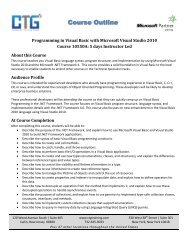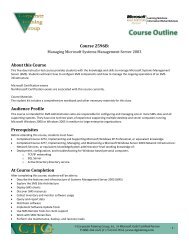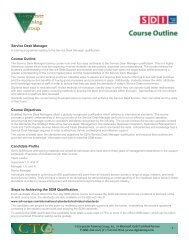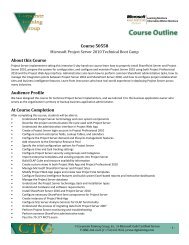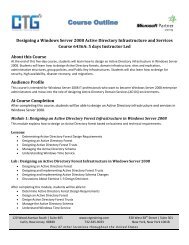Implementing and Maintaining Microsoft SQL Server 2005 Reporting ...
Implementing and Maintaining Microsoft SQL Server 2005 Reporting ...
Implementing and Maintaining Microsoft SQL Server 2005 Reporting ...
Create successful ePaper yourself
Turn your PDF publications into a flip-book with our unique Google optimized e-Paper software.
Learning Solutions<br />
Information Worker Solutions<br />
<strong>Implementing</strong> <strong>and</strong> <strong>Maintaining</strong> <strong>Microsoft</strong> <strong>SQL</strong> <strong>Server</strong> <strong>2005</strong> <strong>Reporting</strong> Services<br />
Course 2793: Three days; Instructor-Led<br />
Introduction<br />
Elements of this syllabus are subject to change.<br />
This three-day instructor-led course teaches students how to implement a <strong>Reporting</strong> Services solution in an organization. The course<br />
discusses how to use the <strong>Reporting</strong> Services development tools to create reports, <strong>and</strong> how to use the <strong>Reporting</strong> Services<br />
management <strong>and</strong> administrative tools to manage a <strong>Reporting</strong> Services solution.<br />
Audience<br />
This course is intended for information technology (IT) professionals <strong>and</strong> developers who need to implement reporting solutions by<br />
using <strong>Microsoft</strong> <strong>SQL</strong> <strong>Server</strong> <strong>2005</strong> <strong>Reporting</strong> Services.<br />
At Course Completion<br />
After completing this course, students will be able to:<br />
Describe <strong>SQL</strong> <strong>Server</strong> <strong>Reporting</strong> Services <strong>and</strong> its components.<br />
Create a <strong>Reporting</strong> Services report.<br />
Enhance a <strong>Reporting</strong> Services report.<br />
Create <strong>and</strong> manipulate data sets.<br />
Use report models to implement reporting for business users.<br />
Configure report publishing <strong>and</strong> execution settings.<br />
Implement subscriptions for reports.<br />
Administer <strong>Reporting</strong> Services.<br />
Implement custom <strong>Reporting</strong> Services applications.<br />
Prerequisites<br />
Before attending this course, students must have:<br />
Exposure to creating reports in <strong>Microsoft</strong> Access or other third-party reporting products, such as Crystal Reports.<br />
Conceptual underst<strong>and</strong>ing of the push <strong>and</strong> pull distribution/subscription paradigm.<br />
Experience navigating the <strong>Microsoft</strong> Windows <strong>Server</strong> environment.<br />
Experience with Windows services (starting <strong>and</strong> stopping)<br />
Experience creating service accounts <strong>and</strong> permissions<br />
Experience with <strong>Microsoft</strong> <strong>SQL</strong> <strong>Server</strong>, including:<br />
<strong>SQL</strong> <strong>Server</strong> Agent.<br />
<strong>SQL</strong> <strong>Server</strong> query language (SELECT, UPDATE, INSERT, <strong>and</strong> DELETE).<br />
- 1 -
Learning Solutions<br />
Information Worker Solutions<br />
<strong>SQL</strong> <strong>Server</strong> System tables.<br />
<strong>SQL</strong> <strong>Server</strong> accounts (users <strong>and</strong> permissions).<br />
Course Outline<br />
Module 1: Introduction to <strong>Microsoft</strong> <strong>SQL</strong> <strong>Server</strong> <strong>Reporting</strong> Services<br />
This module introduces the role that <strong>Reporting</strong> Services plays in an organization’s reporting life cycle, the key features offered by<br />
<strong>Reporting</strong> Services, <strong>and</strong> the components that make up the <strong>Reporting</strong> Services architecture.<br />
Lessons<br />
Overview of <strong>SQL</strong> <strong>Server</strong> <strong>Reporting</strong> Services<br />
Installing <strong>Reporting</strong> Services<br />
<strong>Reporting</strong> Services Tools<br />
Lab 1: Using <strong>Reporting</strong> Services Tools<br />
Exercise 1: Exploring Report Designer<br />
Exercise 2: Exploring Report Manager<br />
After completing this module, students will be able to:<br />
Describe the features of <strong>SQL</strong> <strong>Server</strong> <strong>Reporting</strong> Services.<br />
Install <strong>Reporting</strong> Services.<br />
Describe the <strong>Reporting</strong> Services tools.<br />
Module 2: Authoring Basic Reports<br />
This module introduces the fundamentals of report authoring, including configuring data sources <strong>and</strong> data sets, creating tabular<br />
reports, summarizing data, <strong>and</strong> applying basic formatting.<br />
Lessons<br />
Creating a Basic Table Report<br />
Formatting Report Pages<br />
Calculating Values<br />
Lab 2: Creating a Simple Report<br />
Exercise 1: Creating a Basic Table Report<br />
Exercise 2: Formatting Report Pages<br />
Exercise 3: Adding Calculated Values<br />
After completing this module, students will be able to:<br />
Create a basic table report.<br />
- 2 -
Learning Solutions<br />
Information Worker Solutions<br />
Format report pages.<br />
Calculate values for a report.<br />
Module 3: Enhancing Basic Reports<br />
This module introduces navigational controls <strong>and</strong> some additional types of data regions, <strong>and</strong> discusses how to use them to enhance<br />
a basic report.<br />
Lessons<br />
Interactive Navigation<br />
Displaying Data<br />
Lab 3: Enhancing a Report<br />
Exercise 1: Using Dynamic Visibility<br />
Exercise 2: Using Document Maps<br />
Exercise 3: Initiating Actions<br />
Exercise 4: Using a List Data Region<br />
After completing this module, students will be able to:<br />
Create reports with interactive navigation.<br />
Display data in various formats.<br />
Module 4: Manipulating Data Sets<br />
This module explores data sets to a greater depth, including the use of alternative data sources <strong>and</strong> interacting with a data set<br />
through the use of parameters. Students learn how to dynamically modify the data set underlying a data region by allowing<br />
parameters to be sent to the underlying query. They also learn to use best practices to implement static <strong>and</strong> dynamic parameter lists<br />
when interacting with queries <strong>and</strong> stored procedures.<br />
Lessons<br />
Defining Report Data<br />
Using Parameters <strong>and</strong> Filters<br />
Using Parameter Lists<br />
Lab 4: Manipulating Data Sets<br />
Exercise 1: Using parameters to restrict query results<br />
Exercise 2: Using parameters to filter report data<br />
Exercise 3: Creating dynamic parameter lists<br />
Exercise 4: Using parameters with a stored procedure<br />
If Time Permits: Displaying all categories in a parameter list<br />
- 3 -
Learning Solutions<br />
Information Worker Solutions<br />
After completing this module, students will be able to:<br />
Define report data.<br />
Use parameters <strong>and</strong> filters.<br />
Use parameter lists.<br />
Module 5: Using Report Models<br />
This module describes how to create a report model so that business users can create their own reports without using the full<br />
Report Designer development environment. Students also learn how to use Report Builder to create a report from a report model.<br />
Lessons<br />
Creating Report Models<br />
Using Report Builder<br />
Lab 5: Working with Report Models<br />
Exercise 1: Creating a Report Model<br />
Exercise 2: Using Report Builder to Create a Report<br />
After completing this module, students will be able to:<br />
Create Report Models.<br />
Use Report Builder.<br />
Module 6: Publishing <strong>and</strong> Executing Reports<br />
This module explains the various options you can use to publish reports to the report server <strong>and</strong> execute them.<br />
Lessons<br />
Publishing Reports<br />
Executing Reports<br />
Creating Cached Instances<br />
Creating Snapshots <strong>and</strong> Report History<br />
Lab 6: Publishing <strong>and</strong> Executing Reports<br />
Exercise 1: Publishing Reports<br />
Exercise 2: Executing a Report On Dem<strong>and</strong><br />
Exercise 3: Configuring <strong>and</strong> Viewing a Cached Report<br />
Exercise 4: Configuring <strong>and</strong> Viewing a Snapshot Report<br />
After completing this module, students will be able to:<br />
Publish reports.<br />
Execute reports.<br />
- 4 -
Learning Solutions<br />
Information Worker Solutions<br />
Create cached instances.<br />
Create snapshots <strong>and</strong> report history.<br />
Module 7: Using Subscriptions to Distribute Reports<br />
This module describes how to implement subscriptions so that you can distribute reports either automatically by e-mail or by<br />
publishing reports to a shared folder.<br />
Lessons<br />
Introduction to Report Subscriptions<br />
Creating Report Subscriptions<br />
Managing Report Subscriptions<br />
Lab 7: <strong>Implementing</strong> Subscriptions<br />
Exercise 1: Creating a St<strong>and</strong>ard Subscription<br />
Exercise 2: Creating a Data-Driven Subscription<br />
After completing this module, students will be able to:<br />
Describe report subscriptions.<br />
Create report subscriptions.<br />
Manage report subscriptions.<br />
Module 8: Administering <strong>Reporting</strong> Services<br />
This module discusses how to administer the <strong>Reporting</strong> Services server, how to monitor <strong>and</strong> optimize the performance of the report<br />
server, how to maintain the <strong>Reporting</strong> Services databases, <strong>and</strong> how to keep the system secure.<br />
Lessons<br />
<strong>Server</strong> Administration<br />
Performance <strong>and</strong> Reliability Monitoring<br />
Administering Report <strong>Server</strong> Databases<br />
Security Administration<br />
Lab 8: Administering <strong>Reporting</strong> Services<br />
Exercise 1: Using <strong>Reporting</strong> Services Configuration Manager<br />
Exercise 2: Securing a <strong>Reporting</strong> Services Site<br />
Exercise 3: Securing Items<br />
After completing this module, students will be able to:<br />
Administer the reporting server.<br />
Monitor performance <strong>and</strong> reliability.<br />
- 5 -
Learning Solutions<br />
Information Worker Solutions<br />
Administer the Report <strong>Server</strong> databases.<br />
Administer security.<br />
Module 9: Programming <strong>Reporting</strong> Services<br />
This module explains how to query <strong>Reporting</strong> Services information programmatically <strong>and</strong> how to automate report management<br />
tasks. Students also learn how to render reports without relying on Report Manager, <strong>and</strong> how you can extend the feature set of a<br />
report server by creating custom code.<br />
Lessons<br />
Querying for <strong>Server</strong> Information Using a Web Service<br />
Automating Report Management<br />
Rendering Reports<br />
Creating Custom Code<br />
Lab 9: Programming <strong>Reporting</strong> Services<br />
Exercise 1: Using URL Access to Display a Report<br />
Exercise 2: Building a <strong>Reporting</strong> Services Web Service Client<br />
Exercise 3: Using the Report Viewer Control<br />
After completing this module, students will be able to:<br />
Query server information by using a Web service.<br />
Automate report management.<br />
Render reports.<br />
Create custom code.<br />
- 6 -



